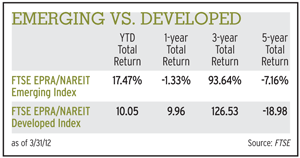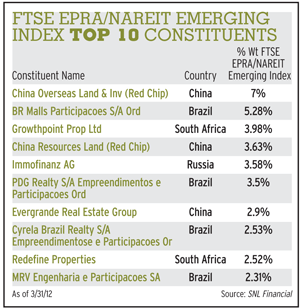While most investors lack a deep understanding of emerging markets overall, most of them know enough to be excited about these countries and the investment opportunities they offer. That excitement is not unwarranted; however, some business sectors within these emerging markets offer greater opportunity than others.
Real estate is one of those sectors, says Joel Wells, portfolio manager of Alpine Emerging Markets Real Estate Fund (AEMEX). He points out that the hallmarks of emerging markets also happen to be the strongest drivers for the real estate sector, particularly residential real estate. That's why his fund is 50 percent allocated to homebuilder stocks.
“Real estate drivers such as job creation, rising incomes, positive demographic trends, urbanization and credit growth are in lockstep with emerging markets growth,” Wells contends. “Real estate companies that are active in emerging markets are trying to target a group of citizens who are ascending the income curve toward middle class.”
While local and regional real estate companies have identified ways to get a piece of the growing emerging markets pie, it's less easy for U.S. investors to do so. Most importantly, each and every fund has its own idea of which countries are emerging markets. For example, Fund A might consider Indonesia to be an emerging market, while Fund B might not.
Most funds that are tagged as emerging markets funds are not focused on real estate and allocate just a small portion of their funds to that sector. The MSCI Emerging Markets Index, for example, has only 1.74 percent invested in real estate, according to Jeff Tjornehoj, head of Lipper Americas Research. He points out that property rights have historically been a “sensitive area” for many emerging market nations because they had a bad experience with colonialism, as well as resource exploitation.
There are only a handful of real estate funds that invest exclusively in emerging markets, and emerging markets typically don't account for a large percentage of global real estate funds. However, Wells contends that this current imbalance will have to shift in the coming years as the emerging market economies continue to expand and transition to a role of global leadership.
AEMEX was the first dedicated emerging market real estate fund that came to market. It started trading in November 2008. In addition, there is a real estate emerging market index — the FTSE EPRA/NAREIT Emerging Index (FENEI), which came on line in January 2009.
“The critical thing for real estate investors to understand is that at this point in time emerging markets funds are not yield-focused vehicles — they're growth vehicles because they're focused almost exclusively on the development cycle,” Wells says. “If they're very comfortable in the REIT world where they are getting their sub-4 percent yield from an established portfolio and modest growth prospects, then emerging markets funds are not the place for them right now. We will see that yield coming through in the emerging markets as the platforms of the real estate companies reach a certain scale and commercial assets stabilize, but not right now.”
Expanding Middle Class
Most people agree the term “emerging markets” is ill-defined and ambiguous, creating an even greater level of confusion about markets that are already lacking in transparency. At its basic level, an emerging market is simply one that has experienced reform, creating a new economic reality.
Over time, the term has evolved to describe regions or countries that have the ability to transform the global economic landscape. Today, the BRIC nations — Brazil, Russia, India and China — are certainly the most recognized emerging markets, primarily because of their existing economic size and their potential for future growth.
Perhaps most importantly, emerging markets challenge the economic supremacy of the G7 (of which the United States is a member). That's one reason why BBVA Research recently coined a new moniker — EAGLEs, which stands for Emerging and Growth-Leading Economies.
BBVA Research, which conducts economic analyses on various geographies for the international banking group, did not look at current measures of economic size but at the new business opportunities that are going to be created based on the concept of incremental growth — an approach that is more akin to a measure of market potential.
The group's chief economist, Alicia García-Herrero, says these EAGLE markets “deserve closer investor attention, given that the business opportunities there will be at least as great as those of the developed world.” These economies are high growth, especially compared with the stagnant economies of the developed world. In addition, their populations are significantly larger, younger and growing faster than those of the developed world.
“Taken together, these factors augur budding business opportunities for investors,” García-Herrero contends. “Frankly, the population dynamics in these markets are much more favorable than in the developed world. Fast-growing urbanization and industrialization are driving ever greater investment in physical capital.”
In 2011, BBVA Research identified 10 emerging countries that will contribute more to global growth than the G7 average in the next 10 years. This year, nine of the 10 original EAGLEs maintained their status after the group updated its forecasts. (The nine EAGLEs which have been confirmed are China, India, Brazil, Indonesia, Korea, Russia, Turkey, Mexico and Taiwan. The so-called fallen angel is Egypt.)
While García-Herrero notes that every EAGLE has its own distinct growth characteristics, she explains that there are two key areas that are common across all EAGLEs: the rise of the middle class and the need for infrastructure.
According to BBVA Research's 10-year forecasts, more than 250 million people will enter the status of “middle class” in the EAGLEs — roughly seven times the number expected for G7 countries. The growing middle class will shift growth opportunities toward consumption expenditure — particularly relevant for retailers.
Meanwhile, the lack of infrastructure remains one of the biggest impediments to increased productivity and potential growth. In this context, infrastructure speaks to transportation, utilities, telecommunications and social (hospitals, schools, prisons, etc.). It also touches on both residential and commercial real estate.
“The infrastructure needs of EAGLEs should be of special interest to construction companies in the developed world looking for new opportunities to boost their production capacity,” García-Herrero notes.
Like the U.S. in the 1950s
It's accurate to compare today's emerging markets to the United States in the 1950s — a period of great economic expansion, population growth (hello, baby boomers) and the development of road and social infrastructure in addition to housing, both high-rise in urban areas and single-family home developments.
In emerging markets, people are shifting from rural living to the city. In addition, residents in emerging market countries are establishing households at a feverish pace — multigenerational living is less and less attractive and the younger population is moving toward marriage and children — a goldmine for residential and retail property developers. In Brazil, for example, annual housing demand is $105 billion based on potential demand of 1.5 million new homes per year, according to J.P. Morgan Research. The most recent data indicates that the country has a housing deficit of 5.6 million houses.
“The difference between emerging markets and the U.S. after World War II is very acute,” Wells says. “The build-out of the U.S. took 20 years. It's not going to take 20 years for these emerging markets — it's happening right in front of us. And it's exciting because investors can participate in that growth, and the developed markets can share its knowledge with emerging markets so they can benefit from the lessons that the development markets have learned.”





